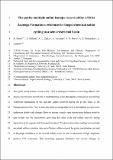The pyrite multiple sulfur isotope record of the 1.98 Ga Zaonega Formation : evidence for biogeochemical sulfur cycling in a semi-restricted basin
Abstract
The pyrite sulfur isotope record of the 1.98 Ga Zaonega Formation in the Onega Basin, NW Russia, has played a central role in understanding ocean-atmosphere composition and infering worldwide fluctuations of the seawater sulfate reservoir during the pivotal times of the Paleoproterozoic Era. That, in turn, has led to a concept that Earth’s atmospheric oxygen levels underwent global-scale changes. Here we present a steady-state isotope mass-balance model to gain insight into the mechanisms governing the sulfur cycle and sulfate reservoir during deposition of the organic-rich Zaonega Formation. We demonstrate that coupling between high microbial sulfate reduction rates and effective sulfate removal by pyrite precipitation can lead to Rayleigh distillation of the basinal sulfate reservoir and development of high amplitude positive δ34S excursions. This modelling approach illustrates that secular changes in sedimentary pyrite isotope trends can be explained by processes that reflect local (basin-scale) fluctuations in sulfur cycling rather than global mechanisms.
Citation
Paiste , K , Pellerin , A , Zerkle , A L , Kirsimäe , K , Prave , T , Romashkin , A E & Lepland , A 2020 , ' The pyrite multiple sulfur isotope record of the 1.98 Ga Zaonega Formation : evidence for biogeochemical sulfur cycling in a semi-restricted basin ' , Earth and Planetary Science Letters , vol. 534 , 116092 . https://doi.org/10.1016/j.epsl.2020.116092
Publication
Earth and Planetary Science Letters
Status
Peer reviewed
ISSN
0012-821XType
Journal article
Description
The research is part of the Centre for Arctic Gas Hydrate, Environment and Climate and was supported by the Research Council of Norway through its Centres of Excellence funding scheme grant No. 223259. A. L. Z. acknowledges support from a Natural Environment Council Standard Grant NE/J023485/2. K. K and A. L. were supported by the Estonian Science Agency grant PRG447 and Estonian Center of Analytical Chemistry. K. P. was supported by the European Regional Development Fund and the programme Mobilitas Pluss grant MOBJD542.Collections
Items in the St Andrews Research Repository are protected by copyright, with all rights reserved, unless otherwise indicated.

